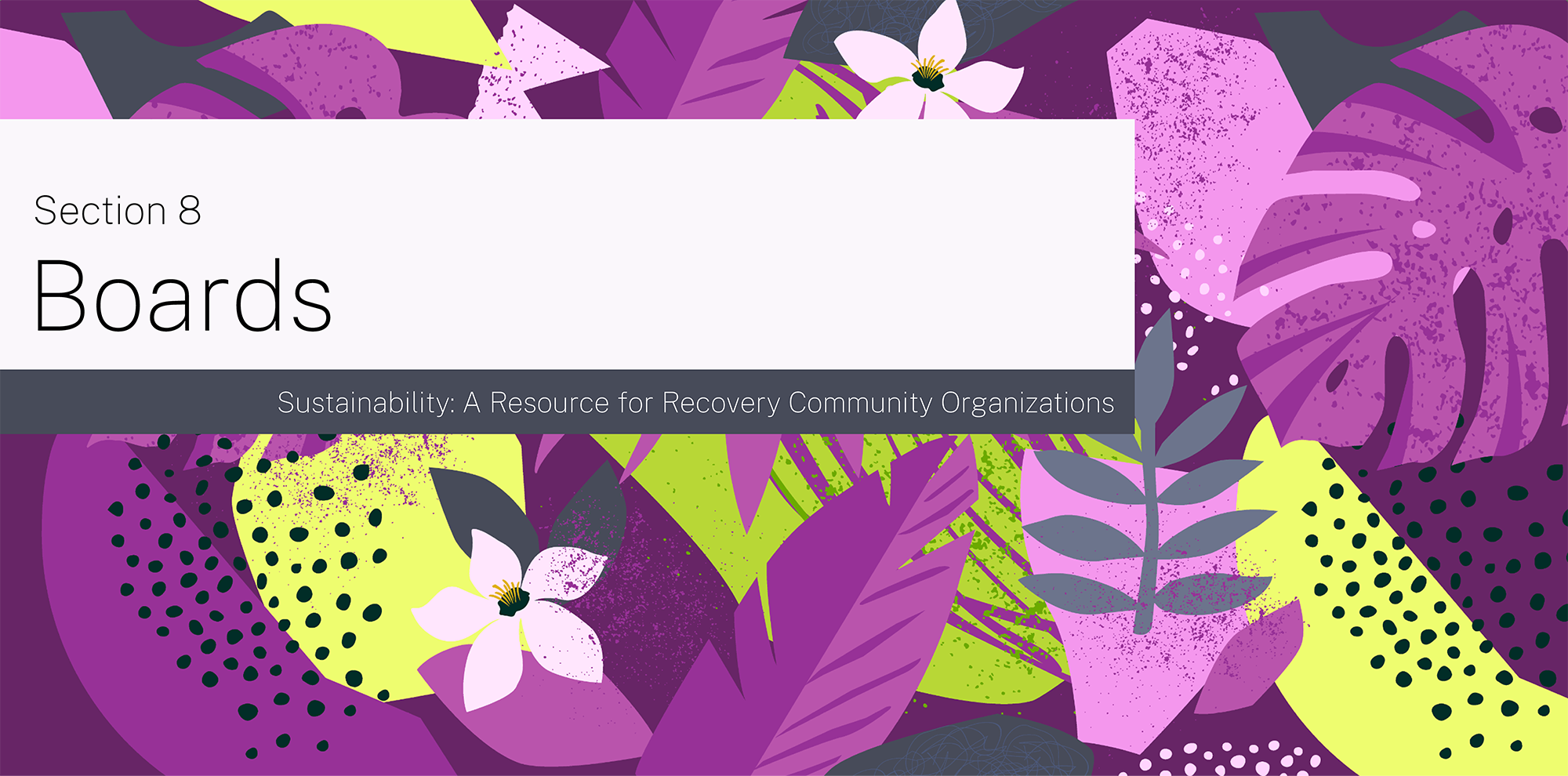
Section 8: Boards
This section focuses on the role, responsibilities, functions, and management of an RCO Board of Directors.
A nonprofit board of directors is a group of individuals who oversee the operations and decisions of a nonprofit organization. These individuals are typically volunteers and have a legal and ethical responsibility to ensure that the organization fulfills its mission. They set the organization's strategic direction, make policy decisions, oversee financial management, and ensure the organization's accountability to its funders and the public.
The board of directors for an RCO, largely consisting of people with lived-experience, plays a vital role in guiding the RCO’s mission and vision. Their firsthand understanding of the complexities of the recovery journey provides unique insight to the board. In fact, the National Standards for Recovery Community Organizations, states, “The organization is peer-led. More than 50% of the Board of Directors or Advisory Board self-identify as people in personal recovery from their own substance use disorders. Additional board members may include family members of persons impacted by substance use disorders and recovery, allies, and persons with co-occurring mental health disorders.”
This emphasis on lived-experience expertise brings authenticity to the board's discussions and decision-making processes. Members of the RCO board are deeply rooted in the recovery community and act as advocates for the needs of the community. They are passionate about changing policies, reducing stigma, and expanding access to recovery support services. Their advocacy work often extends beyond the boardroom, as they actively engage with policymakers, community leaders, and other stakeholders to promote recovery-oriented initiatives. In fulfilling the RCO’s mission, the board ensures their decisions align with what the community expects and needs from the RCO.
At the core of a healthy RCO board is a deep commitment to inclusion. They strive to ensure that diverse voices from the recovery community are represented and given equal opportunity to contribute. This commitment extends to embracing individuals from different backgrounds, cultures, and identities. By emphasizing inclusion, the RCO board creates an environment where everyone’s experiences and perspectives are valued and respected.
Board Source, a leader in nonprofit board development, shares the following:
“Why is board recruitment so important…and so challenging? Because the job of building a board is about more than just filling slots. It is about finding leaders who have skill sets and perspectives that align with your organization’s strategies, goals, and needs—not just now, but into the future. And it’s not just about recruiting one great individual; it’s about having the right blend of skill sets, expertise, community connections, and diverse perspectives and spheres of influence across the board as a whole—which takes some discipline and planning to determine.”
As a leader, ask yourself these questions as you move through the Section:
- What are the roles and responsibilities of the board, the executive director, and what responsibilities are shared between the two?
- How does the board support the RCO’s financial checks and balances? (How are the financials documented, reconciled, and reported and discussed with the board?)
- What annual activities is the board effectively completing? (executive director reviews, annual or strategic planning, review and reporting to the government, annual board review and development)
Resource: Board of Directors: Nonprofit Governance and Structure by Kindful
BoardSource is “the recognized leader in nonprofit board leadership research, leadership, and support.” Consider becoming a member if your organization’s board is struggling in any way.
Roles and Responsibilities of the Board of Directors
What role does our board play, or do we want them to play, in supporting our current and future success?
In addition to fulfilling legal duties and meeting fiduciary responsibilities as described in Section 5, boards play an important role in contributing to the RCO’s culture, strategic focus, effectiveness, and financial sustainability, as well as serving as ambassadors and advocates.
A board of directors for an RCO is a group of people collectively responsible for governing the RCO. This group ensures that the RCO’s processes, policies, and functions are used, reviewed, and adhered to. The board can fulfill various roles based on the RCO’s needs, including oversight and accountability, leadership, and ambassadorship.
Board leadership includes reviewing, planning, and taking action to support the efforts of the RCO. This includes things like:
- Keeping track of, improving, and sharing the mission & vision.
- Planning for the future and for next leaders.
- Making the board better through learning, finding new members, and building a good work environment.
- Working with the ED/CEO and reviewing their leadership.
The board of directors connects the RCO and the communities it works with. They act as ambassadors, listening and communicating to gather and share ideas, issues, and context. This includes things like:
- Listening to community and stakeholders.
- Advocating for the RCO.
- Identifying and/or obtaining resources.
Purpose Driven Leadership prioritizes the mission of the organization, respects the ecosystem, commits to equity, and recognizes power is authorized by the people the organization serves.
Purpose Driven Leadership is integral to the work of RCOs as it underscores the importance of prioritizing the mission of the organization. This leadership style acknowledges the value of respecting the ecosystem, which in the context of RCOs, refers to the recovery community and the broader network of support services and resources. It also emphasizes a commitment to equity, an essential principle for RCOs as they strive to provide accessible and fair recovery support services to all individuals, irrespective of their background. Lastly, recognizing that power is authorized by the people the organization serves reinforces the idea that RCOs exist to serve their community and that their authority stems from the trust and support of these community members.
According to BoardSource, “Purpose Driven Board Leadership” is characterized by four principles:
- Purpose before organization: prioritizing the organization's purpose, versus the organization itself.
- Respect for ecosystem: acknowledging that the organization's actions can positively or negatively impact its surrounding ecosystem, and a commitment to being a respectful and responsible ecosystem player.
- Equity mindset: committing to advancing equitable outcomes, and interrogating and avoiding the ways in which the organization's strategies and work may reinforce systemic inequities.
- Authorized voice and power: recognizing that organizational power and voice must be authorized by those impacted by the organization's work.
Words of Wisdom from the Field
Jack Hovenier, board treasurer, Foundations for Recovery
“An effective RCO includes having a clear understanding of the organization’s mission by the board, staff, volunteers and those they serve. Communication is usually the key to accomplishing that. Having a culture that encourages listening, strategic planning, and the resources available to the organization are characteristics of good communication.
When communication is good, and priorities are understood by all stakeholders, organization planning is much easier. There is an old adage that ‘failing to plan is planning to fail,’ and with an RCO there is always more the organization would like to accomplish than what they have the resources to do. The best way to accomplish the most important things is to align the activities of the RCO with their mission and resources and make sure that everyone involved with the RCO is rowing in the same direction and aligned with the same purpose.”
Resources:
- Board Roles and Responsibilities by National Council of Nonprofits
- Ensuring Long Term Sustainability for Your Nonprofit by BoardEffect
- The Four Principles of Purpose Driven Leadership by Anne Wallestad, Stanford Social Innovation Review (SSIR)
Board of Director Lifecycles
What phase is our board in? Where does the RCO need them to be, and how can we shift the board’s work to respond to the current situation?
Much like nonprofit lifecycles, boards also cycle through different phases. The function of a founding board that breathes life into a vision differs greatly from the responsibilities of a board overseeing a mature RCO. There are four phases in the lifecycle of a board: The Founding Period which is followed by a cycle of Super-Managing, Corporate, and Ratifying.
This article by Julia Classen describes each phase in greater detail; below we offer a brief summary of each as it relates to an RCO.
The Founding Period of an RCO can be divided into two phases: Collective and Sustaining. In the Collective Phase, the focus of the board is on establishing the RCO, creating its mission and vision, and laying the groundwork for future operations. The board members are often the founders of the RCO, deeply passionate about the cause, and involved in day-to-day operations.
As the RCO becomes a sought after resource for the community, it secures funding from government or philanthropic grants, contracted services, and donations. This marks the shift to the Sustaining Phase, where an executive director is hired and the original board members begin to leave the board as they see the RCO becoming stable and self-sufficient. They are replaced by new board members who share similar values and goals. This is an opportunity for remaining board members to pause and create an intentional recruitment strategy that includes a diversity of people and perspectives (more on Board Recruitment later in this section).
The Founding Period for an RCO could take several years. It may take a significant crisis, such as a sudden decrease in funding or a loss of a vital leader to propel the board into the Super-Managing Phase.
During the Super-Managing Phase, board members are quite involved in the management and functioning of the RCO. They offer insights and ideas to the executive director and staff leadership and are more inclined to question the executive director’s actions rather than simply approving them. Supermanaging boards focus their skills and attention on ensuring that the crisis is resolved. Board members take an active role in organizational oversight and stewardship, and they often expect transparency and accountability from the executive director.
The Board Chair and Executive Director Relationship
The relationship that exists between the board chair and the executive director is absolutely pivotal to the overall success of any RCO. The roles that these two individuals play are deeply intertwined, each one operating in a critical capacity that supports and bolsters the other's effectiveness. They are required to function in unison as a cohesive team, providing a unified front that can guide the RCO towards its goals. Simultaneously, they must understand and respect the distinct roles they play within the organizational structure.
The board chair, for instance, is typically tasked with providing high-level strategic direction, while the executive director is generally responsible for implementing these strategies on a day-to-day basis. It's a delicate balance that requires clear communication, mutual respect, and a shared vision for the organization's future.
In a well-functioning RCO, you will find a partnership between a dedicated board chair, who provides strategic oversight and guidance, and an effective executive director, who translates this guidance into action. This relationship, when prioritized and nurtured, can lead to increased organizational effectiveness, improved employee morale, and ultimately, the successful achievement of the RCO's mission and vision.
The key to fostering this successful partnership is regular and open communication, clear delineation of roles, and a shared commitment to the RCO's goals. Both individuals must be willing to listen, collaborate, and adapt as necessary to best serve the RCO's needs.
As major changes in response to the crisis settle and systems of communication and oversight are developed, board members shift to using these systems and structures in the Corporate phase. The board has formed committees that meet regularly and the focus is on long-term planning and sustainability. It's important to remember that a board's role is not to manage the day-to-day operations of the RCO. Instead, they provide strategic direction and oversight, leaving the operational details to the RCO's executive director and staff. This balance allows the board to focus on long-term goals and strategy, while the staff handles the immediate needs of the RCO.
Boards move into a Ratifying phase as board members rotate and new members shift to trusting the structures, reports, and work of staff without asking questions or paying attention to the details. These are boards that are often described as “rubber stamping” the work of the RCO rather than being involved in or pushing the team’s ideas and actions.
These phases represent the natural progression of an RCO as it evolves and matures over time. In the early stages, the focus is on establishing the RCO’s foundation and direction. As the RCO grows, the board’s responsibilities shift to more operational management, and later to strategic oversight and long-term sustainability. This progression reflects the changing needs and challenges that come with each stage of growth in the RCO.
Additionally, going through these phases allows the RCO to benefit from diverse perspectives and expertise. As the board membership changes and evolves, new insights and experiences are brought to the table. This diversity helps ensure that decisions are made with a broad understanding of the RCO’s goals and the wider context in which it operates.
Board Types
What type of board does the RCO need for ensuring its sustainability?
The structure, role, and function of a board of directors changes as an RCO moves through different lifecycle phases (see Section 1 for more on nonprofit lifecycles). For example, in the early stages, when an RCO is just starting or experiencing rapid growth, the board is sometimes known as a “working board”. These members roll up their sleeves and dive into the daily operations or the RCO. But as the RCO evolves, so should the board. In some cases, a board might transform into a “fundraising board”, with a primary focus of bringing in the funding needed to fuel the RCO’s work. As the RCO matures, the board may need to expand, adopt new structures, and take on different roles and responsibilities. Take time to periodically reflect on and adjust the board's roles as your RCO’s needs evolve.
Here are some key characteristics of the most common types of nonprofit boards:

Governance Board
Boards focused on governance provide strategic direction and financial oversight to the nonprofit organization while being less involved in supermanaging daily operations.
All boards must play this role. The difference between a “governance board” and another board in this list is that they may not have any other major expectations of board members beyond strategy, financial oversight, and long-term planning.

Working Board
In addition to governance, a working board is involved in the details and activities of the organization. Smaller nonprofits that have fewer staff and nonprofits that are member-led often include boards that work to support the programs, events, and daily administrative activities of the organization.

Fundraising Board
Fundraising boards ensure there is enough funding to sustain the operations of the nonprofit. Fundraising board members are often brought onto the board with full knowledge that they are responsible for bringing in money to support the organization. Some nonprofits have fundraising boards that are separate from their board of directors, meaning that another group of people is responsible for the governance and oversight of the organization. Board members should always have a clear understanding of their job responsibilities as they join a board.

Community Centric Board
Community centric boards operate with a powerful shift in focus, moving away from making decisions based on what’s best for the organization and instead prioritizing what’s best for the community. Some tentative principles for the Community-Centric Board (CCB) are:
- The work of the board must be grounded in racial, economic, and social justice.
- Boards must constantly reflect the communities being served.
- The board’s ultimate goal is ensuring the community’s well-being, not the organization’s survival.
- The board encourages mutual support and collaboration among different missions.
- Boards are equal, not superior, to staff, volunteers, clients, and other members of the community.
- Lived-experience is valued above wealth and the connection to wealth.
- Boards must play a critical role in collective efforts to bring about racial, economic, and social justice.
Resource: Read more about Community-Centric Boards in this article by Giving Compass (curated article by Nonprofit AF) - The Importance of Promoting Community Centric Boards
Peer Advisory Boards/Councils
Peer Advisory Councils (sometimes referred to as Peer Advisory Boards) for RCOs, are groups composed of individuals who have personal experience navigating substance use challenges and recovery. These individuals come together to provide guidance, support, and advocacy for the overall mission and objectives of the RCO.
These councils play a critical role in ensuring that the RCO effectively serves and empowers the local recovery community. Members of the council provide valuable insights and perspectives based on their own journeys. They bring in diverse personal experiences, knowledge, and skills that are essential for developing and improving the RCO's programs, services, and policies.
The primary function of a peer advisory council is to offer advice and recommendations to the RCO's leadership. They provide input on various aspects, such as strategic planning, program development, community outreach, and resource allocation. By leveraging their personal experiences, these council members can shape the RCO's initiatives in ways that resonate with and best support the individuals it serves.
Peer advisory councils also serve as a source of accountability for the RCO. They help monitor the organization's adherence to its mission and values, ensure that the services provided align with best practices in recovery support, and advocate for the needs and rights of individuals in recovery. They may also help establish guidelines and mechanisms for evaluating the impact and effectiveness of the RCO's programs.
Additionally, these councils foster a sense of community and collaboration among council members themselves. Peer advisory councils provide a platform for people to connect, share experiences, and learn from one another. This supportive network not only enhances the effectiveness of the council but also contributes to the personal growth and development of its members.
Diversity and inclusion are essential considerations when forming and maintaining peer advisory councils for RCOs. Recognizing the importance of diverse perspectives and experiences, these councils strive to include individuals from different backgrounds, cultures, ethnicities, ages, genders, and stages of recovery.
Inclusion of diverse voices ensures that the council's discussions and decisions reflect the wide range of experiences that exist in the recovery community. It helps break down barriers and reduces the risk of biases that could impact the effectiveness and relevance of the RCO's programs and services. By including a diverse range of perspectives, the council can develop initiatives that are culturally responsive to the needs of more community members.
Inclusive peer advisory councils also provide opportunities for people from historically and intentionally marginalized and underrepresented communities to have a voice in shaping the RCO's initiatives. This is necessary for addressing systemic inequities and ensuring that the RCO considers the remarkable strengths of and challenges faced within these communities.
Resource: The Peer Support Coalition of Florida offers a way to get started with their guide and recruitment package (linked below).
Strategic Guide to creating an effective Peer Advisory Council
Peer Advisory Council Recruitment Package
Recruiting and Selecting Board Members
What skills, experiences, perspectives, or connections are needed on the board of directors to better serve our mission and our community?
The board of directors, with support from staff, is responsible for finding and recruiting new board members. The individuals who serve on the board play a significant role in shaping the direction and success of the RCO, so it’s important to carefully consider creating a recruitment strategy. Some RCOs form a Nominations Team that takes an active role in identifying and reaching out to potential board members, ensuring that the board is representative of the community it serves. A word of caution - when we rely solely on chance or word of mouth for recruitment, it can lead to a lack of diversity and “groupthink”. This will have a negative impact on the RCO, hinder problem-solving, and limit the effectiveness of the board. By actively seeking out individuals with diverse backgrounds, experiences, and perspectives, we can create a board culture that values open dialogue, collaboration, and critical thinking.
RCOs, generally, need to have a minimum of 3 or 4 board members to be in compliance with their organizational bylaws and their fiduciary responsibilities with the state. Most seek to maintain a larger number of board members to have a healthy, functioning board.
Creating new application or nomination processes is the perfect time to review and revise board member job descriptions, the board members’ skills and attributes matrix, and the application process. Below are brief descriptions of each of these elements of the board member selection process. Here is a brief description of the Board recruitment process from BoardSource.
Resource: Practicing Equitable Board Recruitment by Cause Strategy Partners
Does the board member job description reflect what we want the board working on? Who is responsible for updating it?
Board member job descriptions communicate and clarify board roles and expectations. These descriptions should include key information, such as how board members support the RCO’s mission and vision through active board meeting attendance, committee involvement, and leadership roles. Be sure the descriptions outline term lengths and commitment, any expected financial contributions, and specific ways board members must show up for or be involved in the RCO’s events. By clearly defining these roles and responsibilities, job descriptions help in planning and evaluating the performance of each board member, as well as the collective contribution of the board as a whole.

Board Member Job Descriptions
Resource: See this Board Job Description from Recovery Dharma Global to see an example of what to include. Or use this Board Member Job Description Template from BoardSource to create or revisit your current descriptions.

Board Member Matrix
What are the skills, identities, lived experiences, and capacities on the current board? What is missing that might strengthen the board and the organization?
High impact boards have the right mix of skills, perspectives, and passion to help the RCO succeed. A useful way to evaluate the strengths of your current board and identify gaps in experience or expertise, is to design a matrix of board member characteristics.
As a board and staff, use the board member matrix to determine what expertise, perspectives, and attributes are essential to incorporate into the board. Identifying these gaps, as well as specific skills the RCO will need over the next 2–4 years, will steer the board member recruitment process in the right direction.
Resource: Here is Skills and Capacity Matrix to get your RCO started.
In addition to having current board members complete the matrix, consider including the matrix into the application process for potential board members. By doing so, you not only gain a clearer understanding of the strengths and assets individuals might bring to the board, but potential board members gain insight into the specific qualities the RCO board needs and values.

Search Process
How can all board members, staff, volunteers, and other stakeholders play a role in finding potential board members?
When planning to invite new members to the board, the board, staff, and volunteers should identify the roles, skills, experiences, and perspectives that will benefit the RCO most. Prioritize individuals who have a deep understanding of the experiences and needs of the communities that have been historically and intentionally excluded. Seek a range of perspectives, ensuring voices from different racial and ethnic backgrounds, genders, ages, and lived experiences are represented.
While the search for potential board members is an ongoing process, RCOs can take focused steps at regular intervals, such as annually or every 2 years, to reflect on board membership. A Nominations Team, some key staff and volunteers, should lead the process of announcing the search for board members and moving through the application, review, interview, and selection process to get to recommending new board members to the current board.
Whether the search process is ongoing or time-bound, the team should use a structured process to move potential board candidates through the process. Many organizations have a process that includes some version of the follow steps:
- Board matrix and organization review (described above)
- Call for applicants and sharing of board job description: share the announcement widely, through newsletters, signs, social media, staff, and nonprofit or sector-specific channels.
- Board members send out targeted invitations: personal invitations, messages through LinkedIn to potential candidates.
- Informational interviews/conversations: Nominations Team members field questions and hold conversations with applicants to share more about the RCO and the board.
- Applications review: identify a date at which all applications will begin to be reviewed.
- Interviews: Whether conducting one or multiple interviews, each applicant being considered should meet with a board officer, staff leader, or seasoned volunteer to talk about the RCO, the role and hopes for the board, and the applicant themselves. This gives both sides a chance to better understand each other and begin to feel out whether the potential candidate might be a good fit.
- Recommendation: Every board member is voted upon by the board or by the membership, depending on the type of nonprofit. Based on the organization’s bylaws, the Nominations Team may recommend a slate of candidates for the next board term, or they may recommend the addition of individual members for a vote.
Resource: The Nominations Team (and others) can use the RCO Board of Directors Nomination Matrix to collect nominations from board members and other stakeholders. It is suggested to put the matrix spreadsheet into a shareable format like a Google Sheet and create a link to share widely.

Announcing the Search
The call for applicants or nominations to the board can be challenging. “Where do we find board members?” is a question many RCOs ask, especially when they are looking to diversify the board.
Potential board members can be found in both likely and unlikely places. Start with your dedicated and active board members, key staff, volunteers, and program participants. Who do they know who might be a good fit for your board in terms of experience (lived and professional), mission alignment and time to give? Consider your donors. Donors are already engaged and committed to an RCO’s mission, and the more engaged donors are with an organization, the more they will contribute their own resources, time and connections. Reach out to boards of other local nonprofits. Ask if they know anyone who might be interested in serving on your board. Leverage your networks. Share on social media and ask others to repost, or use the search and filter functions on LinkedIn to find people open to joining a nonprofit board. Reach out to the community you serve. Share in leadership programs, social groups, community awareness and educational events, activity centers, cultural centers and faith based organizations.

Finding the Right Fit
To ensure transparency and equal opportunity, it is essential to establish clear evaluation criteria that focus on the qualifications, skills, and experience outlined in the applications. Begin by forming a diverse and representative review committee, including individuals from various backgrounds who understand the RCO's mission. This diverse perspective helps guard against unconscious biases.
Each application should be evaluated based on predetermined criteria, such as relevant expertise, commitment to the mission, and potential contributions to the RCO's governance. The Nomination Team could use an RCO Board Candidacy Rubric for considering each applicant in the same way. Blind reviews, where identifying information is withheld, can also be implemented to minimize bias. Remember, an unbiased board application review process is not just about promoting fairness; it is an opportunity to cultivate a truly representative board that reflects the diverse voices in the recovery community.
Resource: Take a look at these articles to get started with potential interview questions OnBoard, 5 Essential Board Member Interview Questions and Sidecar, Essential Interview Questions for Board of Directors.
As you develop processes that work for the Nominations Team and the board in recruiting and selecting candidates, document the process for future board members. Remember, board recruitment is an ongoing process; your RCO should always be on the lookout for new board members, so having a structure to rely upon is very helpful.
Onboarding and Working With Board Members
How do we make new board members feel welcomed, appreciated, and connected so they can best support the organization?
Onboarding and orienting new board members is an important part of board development and a board’s responsibilities. Board orientation requires intentionality and advanced discussion, which helps a board articulate or clarify how they want to work together. Regular onboarding of new members offers boards an opportunity to set, or reset, expectations, educate board members about the RCO's mission and the role of a board, and reconfirm annual schedules, processes, and roles of individual board members and committees. Thorough onboarding and orientation lends itself to creating effective, contributing board members.
It is also important to have established policies regarding term limits, conflicts of interest, the process and criteria for re-nomination to the board or for removing a board member, and the board’s role in fundraising. A version of all of these policies are usually outlined in the organization’s bylaws, and they should be reviewed annually and revised as needed. In addition to the review, it is important to document the date of the review/revision on each policy document and the board approval in the board meeting minutes.
Board Manual
How are board members updated about the work of the organization? How can we give them a more holistic picture of the RCO?
Similar to an Employee Policies and Procedures Manual, board members should receive their own manual that includes information board members need to better understand the current status of the RCO, the board’s areas of responsibility and focus, and how to connect into the board’s various structures and processes. Here is a template for RCO Board Manual Content with key content to include in a board manual.
Onboarding board members should include time for members to read through the manual and ask questions. Talking through job descriptions, organization-specific policies, meeting schedules, and any agreements they must sign is important.
Below are more detailed lists of information that may be relevant and important to share with all board members or to track and maintain elsewhere within board documents. Some of these items are also needed to complete a 990 or in case of an audit.
Logistics & Policy Information
- List of current board members’ names, contact information, bios, and roles within the board
- Board terms of all current board members
- Board member tracking sheet, capturing all past board members’ terms and roles
- Statement of responsibilities and expectations of board members
- Board meeting attendance policy
- Conflict of Interest policies signed by board members
- Miscellaneous documents, including pledge forms, insurance policies, etc.
- Operational calendar that can be updated annually
RCO & Board Operational Guidelines
- Policy for recruiting, orienting, informing, and cultivating board members
- Policy for unplanned board member exit
- Policy for emergency/unplanned exit of the executive leadership (Executive Director)
- Expectations and guidelines for board member performance self-evaluation
- Plan for interviewing and selecting a board chair
- Descriptions of different committees, task forces, or subcommittee
Meeting Minutes & Reports
- A year’s worth of past board meeting minutes
- Reports and documentation from past committee meetings
- Any other reports, metrics, and minutes from directors
Finance & Fundraising Reports
- Financial reports for the nonprofit, including prior annual report, most recent audit report and current annual budget
- Financial forms required for a nonprofit organization, including Form 990, banking resolutions, and investment policy
- Details around fundraising, including current donor list, fundraising plan, and a list of go-to fundraising sources
Marketing Information & Supplemental Information
- Contact information, including the nonprofit’s website and donation site
- Promotional materials such as marketing pages, branding guidelines, and messaging overviews
- Guides for any tools or resources your team is using to manage board output
- Emergency contact info and communication plan
Bylaws
Are we in compliance with our bylaws? When was the last time we reviewed our bylaws?
It's essential for both the board and staff to continually ask, “Are we living in accordance with our bylaws?” Bylaws serve as the foundation of the organization, outlining its structure and duties, and providing guidelines for effective governance. If any misalignments arise, it's an opportunity for RCO board members and staff to assess and potentially realign actions or even revise the bylaws themselves. For instance, if a board finds itself with only 2 members when 3 are required, the focus shifts to recruiting new members to ensure compliance. Conversely, if the board exceeds a specified 15 members, a thoughtful reflection can determine whether this number still serves the organization's best interests.
Bylaws not only define responsibilities and shape how an RCO operates, they ensure the RCO stays true to its mission and remains legally compliant. An RCO’s bylaws should include information about the inclusion of people with lived-experience in decision-making processes and the involvement of people with lived-experience in governance and leadership roles.
An RCO striving for excellence in the recovery community would take a collaborative approach, engaging a variety of RCO stakeholders in the review and updating of bylaws and addressing issues that may limit the RCOs growth and progress.
Board Planning
What is the board’s unique role and responsibility in strengthening and sustaining the nonprofit?
Having a board work plan helps a board to be more strategic and effective rather than just operating from one meeting to the next. The full board, as well as board committees should decide before the beginning of the year what they want to do and whose responsibility it is to complete each task (here is a way to think through the board annual work plan). This practice allows the board and committees to prioritize work, achieve goals, and keep the work moving forward.
Board Committees
What committees does the board need to have to fulfill its responsibilities to the organization?
Board committees are small groups of individuals who advise the board on a specific area of operations or oversee the completion of the tasks on behalf of the full board. Many committees are listed or briefly described in the RCO’s bylaws. According to Leading with Intent, a BoardSource resource, the most common standing board committees are Finance; Executive; Fundraising/ Development; and Governance/Nominating. Other potential committees include Membership and Marketing/Communications. Consider adding task forces, work groups, or ad hoc committees to fulfill board duties for things like special events or fundraisers.
It’s important to have a structure in place around committees and to lay out detailed expectations around the charter (i.e. roles, responsibilities, authority) of each committee. BoardEffect offers guidance and a template for Board Committee charters. It is important to note, committee work should be done outside of the regularly scheduled board meetings. While board meetings are not the appropriate place for committee work to be done, committees should have a standing time in the board meeting agenda to report out on their work.
Resource: To find out more about how to best structure your nonprofit’s board and the committees of the board, see How to Structure your Nonprofit Board from BoardSource.
Board Review
How well is the board fulfilling its responsibilities and supporting the active participation of each board member?
One way board of directors fulfill their fiduciary duty of obedience is by conducting an annual review of both themselves and the executive director. The review process serves not only as a means of evaluation but also as a tool for growth and improvement. By assessing what is going well and what could be better, board members can more fully engage, effectively fulfill their roles, and ultimately, better support the RCO.
The board review process is often a time of reflection, discussion, and planning, and it can support the board member search process as well as the annual planning process. Here is a sample board assessment that covers the fiduciary and leadership responsibilities of a board and assesses board member satisfaction.

Section 8: Pause & Reflect
At the end of each section, take time to reflect on what was presented, consider how it applies to your unique situations, structures, and goals of your RCO, and identify possible next steps.
At the end of each section, take time to reflect on what was presented, consider how it applies to your unique situations, structures, and goals of your RCO, and identify possible next steps.
- What information or ideas were new, interesting, helpful, or hopeful in this section?
- How does this section guide your organization in adapting, improving, or building upon the RCO Guiding Principles and Practices listed below? For each point, consider "What is going well?" and "What could be better?"
- Led and governed by members of the recovery community
- Grassroots, local, community-based decision-making
- Participatory practices are emphasized, promoting community involvement and collaboration.
- All pathways and recovery journeys are honored and celebrated
- Diverse, equitable, and inclusive policies, practices, and services
- Recovery oriented language that is strengths-based and person-centered
- What areas of your organization do you think might need some work or review?
- What is one small step you can take in the next 2–3 weeks to begin doing that work or review? (This could be emailing someone to schedule a meeting, finding and printing the most up to date draft of something, or asking someone to review draft language.)

CAPRSS Considerations
At the end of some sections in this guide, you will find a segment titled “CAPRSS Considerations”. These segments highlight particular aspects of Council on Accreditation of Peer Recovery Support Services (CAPRSS) standards that relate to the section topic. See the paragraph below for more information on pursuing CAPRSS accreditation.
It is critical for an organization that supports recovery initiatives to have a board of directors that is responsive to and inclusive of local recovery communities.
CAPRSS's practices-related standards under the domain of Governance and Program Oversight emphasize the significance of board member selection, onboarding, development, and training. That it is commensurate with the board's responsibility to ensure that the organization's policies and practices adhere to the principles of effective governance.
Utilizing a board composition that is representative of the recovery community underscores the significance of the values and perspectives held by the recovery community.


